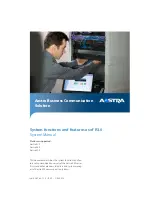
4.
Open
the
front
adapter-support
bracket
and
remove
the
rear
adapter-retention
bracket
from
the
PCI-X
slots
(see
“Installing
an
adapter”
on
page
29
for
instructions).
You
might
also
have
to
remove
longer
adapters
for
access
to
the
SCSI
connectors
on
the
system
board.
5.
Connect
the
SCSI
signal
cable
end
labeled
“PLANAR”
to
the
connector
for
SCSI
channel
A
on
the
system
board.
See
“System-board
internal
connectors”
on
page
3
for
the
location
of
the
SCSI
channel
A
connector.
6.
Route
the
SCSI
cable
to
the
adapter
slot
that
has
the
special
SCSI-knockout
slot
cover
on
the
back
of
the
computer
(see
“Connecting
the
cables”
on
page
42
for
an
illustration
of
the
SCSI-knockout
slot
cover,
normally
in
PCI
slot
3).
Make
sure
the
cable
does
not
block
the
flow
of
air
to
the
hard
disk
drives.
Note:
You
can
move
the
special
SCSI-knockout
slot
cover
to
a
different
slot
if
needed.
7.
Remove
the
SCSI-connector
knockout
from
the
PCI-X
slot
cover;
then,
insert
the
external
SCSI
connector
on
the
SCSI
cable
into
the
knockout
opening
and
secure
it
with
the
attached
screws.
8.
Replace
any
adapters
you
removed
in
step
4.
Close
the
front
adapter-support
bracket
and
replace
the
rear
adapter-retention
bracket.
9.
Replace
the
support
bracket
(see
“Removing
and
installing
the
support
bracket”
on
page
12).
10.
Replace
the
cover
(see
“Replacing
the
side
cover”
on
page
41).
11.
Reconnect
the
external
cables
and
power
cords.
Turn
on
the
attached
devices,
and
turn
on
the
computer.
12.
Use
the
SCSISelect
program
to
configure
SCSI
channel
A
(see
the
User’s
Guide
for
information
about
using
the
SCSISelect
program).
Installing
an
additional
microprocessor
The
following
notes
describe
the
type
of
microprocessor
that
the
server
supports
and
other
information
that
you
must
consider
when
installing
a
microprocessor:
v
The
server
comes
with
one
microprocessor
and
supports
up
to
two
microprocessors.
v
Read
the
documentation
that
comes
with
the
microprocessor
to
determine
whether
you
must
update
the
basic
input/output
system
(BIOS)
code
in
the
server.
To
download
the
most
current
level
of
BIOS
code
for
the
server,
go
to
http://www.ibm.com/pc/support/.
v
(Optional)
Obtain
an
SMP-capable
operating
system.
For
a
list
of
supported
operating
systems,
go
to
http://www.ibm.com/pc/compat/.
v
The
microprocessors
must
have
the
same
cache
size
and
type,
and
the
same
clock
speed.
Microprocessor
internal
and
external
clock
frequencies
must
be
identical.
You
can
use
the
Configuration/Setup
Utility
program
to
determine
the
specific
type
of
microprocessor
that
is
in
the
server.
v
Terminator
cards
are
not
required
for
empty
microprocessor
sockets.
However,
for
airflow,
an
empty
microprocessor
socket
must
contain
a
microprocessor
baffle.
v
The
microprocessor
speeds
are
automatically
set
for
this
server;
therefore,
you
do
not
have
to
set
any
microprocessor
frequency-selection
jumpers
or
switches.
v
The
system
board
contains
an
integrated
voltage
regulator
for
microprocessor
1;
you
must
install
a
voltage
regulator
module
(VRM)
on
the
system
board
when
you
install
microprocessor
2.
The
VRM
comes
in
the
microprocessor
option
kit.
v
If
you
must
replace
a
microprocessor,
call
for
service.
Chapter
2.
Installing
options
25
Summary of Contents for eServer xSeries 226Type 8648
Page 1: ...xSeries 226 Type 8648 Option Installation Guide ERserver...
Page 2: ......
Page 3: ...xSeries 226 Type 8648 Option Installation Guide ERserver...
Page 56: ...44 xSeries 226 Type 8648 Option Installation Guide...
Page 62: ...50 xSeries 226 Type 8648 Option Installation Guide...
Page 70: ...58 xSeries 226 Type 8648 Option Installation Guide...
Page 74: ...62 xSeries 226 Type 8648 Option Installation Guide...
Page 75: ......
Page 76: ...Part Number 88P8978 Printed in USA 1P P N 88P8978...
















































